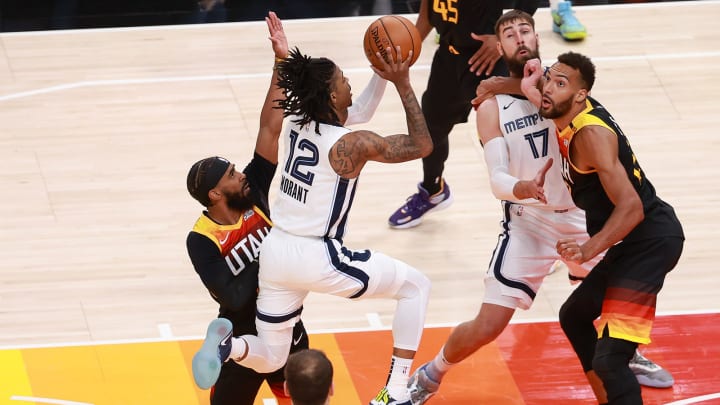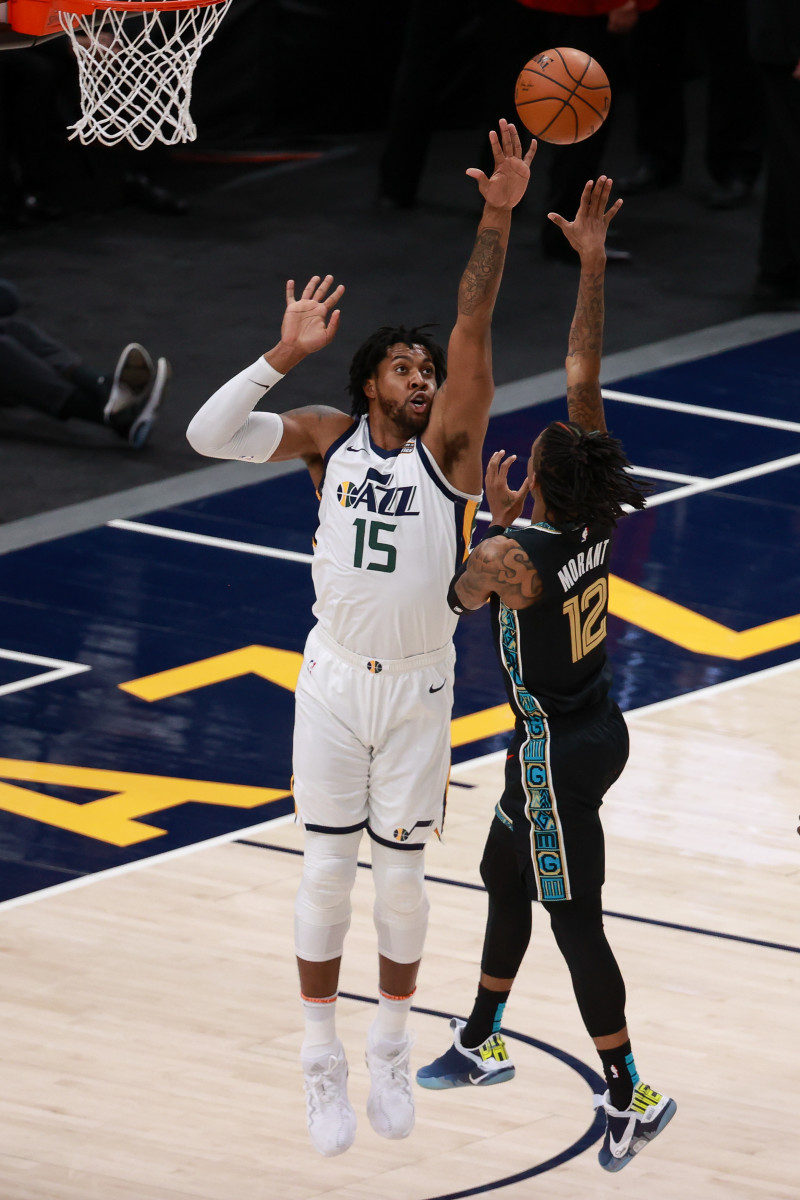The Grizzlies Live and Die by the Floater

Welcome to the Morning Shootaround, where every weekday you’ll get a fresh, topical column from one of SI.com’s NBA writers: Howard Beck on Mondays, Chris Mannix on Tuesdays, Michael Pina on Wednesdays, Chris Herring on Thursdays and Rohan Nadkarni on Fridays.
If the Grizzlies somehow win their next three games and upset the Jazz, their year-long embrace of a shot that’s teetering on the edge of NBA basketball’s endangered species list will almost definitely play a major role.
Memphis attempted over a couple hundred more floaters than any other team this season. It’s a sizable part of its identity when a vast majority of the league treats the shot like a self-contaminant. It’s also been particularly relevant in this series, against a Jazz team that constructed its elite defense by specifically forcing offenses to settle for the very looks Memphis adores. It’s a fascinating battle within the larger war, one that—depending on how you look at it—can be either the Grizzlies’ saving grace or fatal flaw.
The floater is not a corner three. It’s not a layup or a dunk. It’s unlikely to draw a foul and is often launched in traffic by a shooter who must maintain balance despite hurtling their body into the paint before delicately lobbing the ball over a backpedaling shot blocker’s fingertips. It requires touch, and by yielding only two points with a high degree of difficulty, is a natural enemy of analytics and efficiency.

But as Jazz guard Mike Conley put it last year: “With the way defenses play, dropping down, their bigs being way back in the paint, you have that shot pretty much anytime you want it.” When taken by players who actually know how to make them, floaters are also almost impossible to stop; in their most ideal form they exist as the perfect antidote against someone like, say, Rudy Gobert, who erases everything at the rim while allowing his teammates to stay home along the three-point line.
On the surface, that’s pretty convenient for the Grizzlies, considering they have several players who know how to make them. A league-leading 29.4% of Memphis’s shots in the regular season came between four feet and the free throw line, unofficially labeled the floater zone. In the playoffs that frequency has shot up to 34.7%, higher than every other team and 13.5% above the league average.
According to Synergy Sports, five Grizzlies had at least 20% of their shots classified as a runner (aka a floater) this season: Ja Morant, Tyus Jones, Xavier Tillman, Brandon Clarke and Kyle Anderson. No other team had more than three players above 20%, while a vast majority finished with either one or zero players above that mark.
Also according to Synergy Sports, Memphis ranked fifth in floater field goal percentage (46.4%) during the regular season, while Morant has been their most potent practitioner in the playoffs: 41% of his shots come from the short midrange and a whopping 52.4% of his floaters have gone in.
“It kinda plays in our favor,” Morant said when I asked before Game 3 about the impact their floaters can still have against the Jazz. “Obviously you can’t force that shot. But … I feel like we have a lot of players who are very comfortable shooting those shots. So it kinda helps us out.”
(As Jazz coach Quin Snyder said on television during Game 4: “We’re making [Morant] shoot floaters. Unfortunately he’s pretty good at that shot.”)
Morant has tried to cremate Gobert on several occasions in this series, but has also recognized when his explosiveness might be null and void, or at least less effective than a touch shot that can’t be rejected.
Grizzlies coach Taylor Jenkins understands why the floater matters against Utah, but also isn’t particularly enamored with how frequently his team lets them fly, despite having several players who harness them in a beneficial way.
“I’d say it’s nice to have in your arsenal. All season long, obviously against the Jazz who kind of force you into those shots, it’s helpful,” Jenkins said. “But we’ve gotta find more balance. We’ve talked about that over the course of the season. The paint has been a big key for us. Obviously the mid-range and the floater game has been big for us. But we’ve definitely stressed the ability to try to get more threes in a lot of different areas: the transition game, our pick and roll game, just get the ball moving around a little bit more.”
No player in the league can speak to the floater’s value better than Grizzlies point guard Tyus Jones, who has a higher floater frequency than any other player in the league by a significant margin. According to Synergy Sports, 43% of all Jones’s shots were floaters this season. In second came Trae Young, at 35.7%. When he lets the ball go, Jones tries not to aim for the backboard or any part of the rim. He wants it to fall straight through the hoop. But the speed of the game makes that goal so hard, especially in the playoffs.
“Sometimes if it’s a difficult angle or your momentum might be carrying you from one side to the next, you kinda just have to get it up on the rim,” he told me. “Whether it’s jumping off one foot, jumping off two feet, I think trying to get on balance is the most important piece for me before I get my floater up. And then the arc on the floater allows it, even if it does hit the rim, to have a soft landing and a soft touch to roll around the rim and drop.”
Jones also credits the floater as a shot that can set up different passes. When he runs a pick-and-roll, it can help engage a dropping big man who has to take a step higher than he’d otherwise like, forcing help defenders to concern themselves with a rolling screener a beat sooner. Here’s an example from this series, where Gobert is up and active to prevent Jones from getting a clean look at the rim. He reacts by flipping a pass out to De’Anthony Melton, who blows by the closeout and makes a play.
The Grizzlies have shown they can win taking such difficult shots at a high volume (in their play-in win over the Spurs, they attacked from the floater zone more than any other area on the court), but—going back to Jenkins’ comment—the fact that only the Wizards have a lower three-point rate in these playoffs, and only three teams were below the Grizzlies during the regular season, is a natural concern. (Put another way, in the playoffs they’re averaging 30.2 shots per game outside the restricted area but inside the paint. The Wizards rank second with … 24 attempts.)
Some of that is because of Utah’s defense, and some is due to Memphis’s personnel. Morant made 30.3% of his threes during the regular season and drilled as many in their play-in win against the Warriors (five) as he has in this series. Elsewhere, the Grizzlies’ best outside shooters (Grayson Allen, Desmond Bane and Melton) all come off the bench while Jaren Jackson Jr.’s three-point accuracy has plummeted this year after he nearly shot 40% during his sophomore season.
For Memphis to eventually get where it wants to go, the three-point shot will have to become more ingrained in who they are. But for the rest of this series, at least, they’ll live and die on a shot other teams don’t even feel the need to practice.
“We’re just taking what the defense gives us,” Jones said. “And if they’re gonna invite the floater, we’re definitely not gonna turn it down. I feel like it’s an art form that doesn’t get as much notice as it needs to. We’re trying to keep the floater alive.”
More NBA Playoff Coverage:
• Chris Paul Is Back, and He Brought the Suns With Him
• The Mental Peril of This NBA Season
• Atlanta Is Falling in Love With Trae Young
